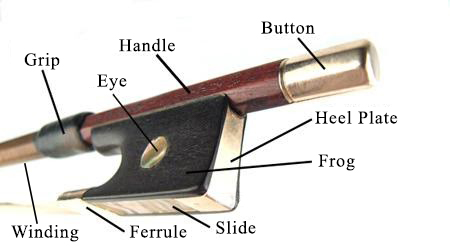
Q: What are your hours?
A: We are open Monday, Wednesday and Fridays, from 10 am to 4 pm.
Q: Where are you located?
A: Salchows is located at 119 W 57th St, suite 1414 between 6th and 7th avenues.
Q: What trains are you near?
A: The Q, N, R 57th Street stop; 53rd and 7th avenue station for the B, D and E; and the 1 train to Columbus Circle or 50th Street.
Q: Do I need to make an appointment?
A: Yes. Appointments are required.
Q: What methods of payment are available to me?
A: We take cash, checks, debit and credit cards.
Q: How much is a bow rehair?
A: Violin, viola and cello bows are $90, and bass bows are $100, plus tax.
Q: How soon will I get my bow back?
A: For rehairs you will get your bow back in the afternoon of the next business day. For grips and windings they should be available the next business day. All other repairs must be seen in person and are dependent on the extent of the job and how busy the shop is.
Q: I don’t live in New York City; may I ship a bow to you for a rehair?
A: Yes! Before shipping please contact the shop to let us know you would like to send us your bow. Include a note in the package with your contact information and details about the work you would like. The hair should be completely loose, and if you are unable to loosen the hair completely please cut the hair. If you need detailed instructions on how to ship your bow, click here.
For international shipments please contact the shop prior to sending for further instructions.
Q: Can you fix my bow?
A: We do all repairs, however, we need to first examine the bow. The most common repair work include: rehair, replacing grips, fixing the winding, replacing slides and pearl eyes, and adding protective end covers and tubes. If you are uncertain how to describe what part of the bow you need fixed, please consult our glossary by clicking here.
Q: How much will a repair cost?
A: We have set prices for the most common work as described above. For damage beyond normal wear and tear, we would need to examine the bow to provide an estimate.
Q: How do I describe what’s wrong with my bow?
A: We’ve provided an online glossary ( click here) for your reference.
Q: I broke the stick. Is it worth fixing?
A: It depends on the damage and where it’s broken, as well as the original value of the bow. Please email the shop photos of the break and we will advise from there.
Q: How much does it cost to get an estimate on my bow?
A: We do not charge to examine a bow for a repair estimate.
Q: How do I get my bow appraised for insurance purposes?
A: We first need to see the bow in person. Insurance letters are determined by the current condition of the bow, which must be examined in person. If you do not live in the area, you may ship the bow to us (see shipping a bow by clicking here). Please include instructions and a phone number with which we can reach you. The cost for an insurance letter is $75 for a new letter and $20 for letter updates.
Q: How much is my bow worth?
A: We provide insurance letters after examining the bow in person. However, insurance appraisals are for insurance purposes only. You may drop off a bow or ship it to our shop. (Click here for instructions on how to ship a bow.)
Q: My bow has broken. Will this affect the value of the bow?
A: It depends on the nature and extent of damage.
Q: What is a certificate of authenticity?
A: A certificate of authenticity states the provenance of the bow, as determined by Isaac’s expertise. It states whether or not all parts are original, and the materials used on the bow.
A certificate does not remark on condition.
Q: How much do you charge for a certificate?
A: A certificate costs 3% of the bow’s value with a minimum of $500.
Q: Do I need to make an appointment to look at bows?
A: Yes. You are welcome to make an appointment here.
Q: How much do your bows cost?
A: We have a wide range of bows, the best thing is for you to tell us your price range and preferences, and work from there. Antique bows can range from several thousand dollars to hundreds of thousands of dollars.
Q: What kind of bows do you have?
A: We specialize primarily in antique French, German and English bows. The modern bows we carry are made by Isaac and William Salchow.
Q: Can I trade in a bow that I own already?
A: It may be possible to do a trade-in towards a new bow if we own the bow you would like. We need to look at the bow and decide whether we would be interested. (For consignments, see below.)
Q. Do you sell cases?
A. Yes, we sell single, double and triple Bobelock cases. Please call to inquire pricing.
Q. Do you sell strings?
A. No, we sell bows, rosin and bow cases only.
Q. What do you sell other than bows?
A. We sell bow cases, and rosin.
Q: Do I need to make an appointment to try out a bow?
A: Yes. You are welcome to make an appointment here.
Q: Can I take a bow or two out to try at home?
A: Yes. After your appointment to try bows in the shop, you are welcome to take up to three bows home to try further.
Q: How long can I keep a bow out?
A: Generally one week.
Q: I don’t live in New York City, will it be possible for you to ship bows for me to try?
A: It depends on many factors, but yes, it is possible. Contact the shop to discuss what you are interested in. Unless you are looking for something specific, it is always better to try out bows in person, in the shop, so you have a broader selection.
Many of the bows we sell and restore are shipped to us from around the world. The most important aspect in shipping a bow is how it is packed inside the shipping container. Whether you choose a major independent shipping company, such as Fed Ex, UPS, etc., or the USPS, how you pack your bow is the key to getting it to us safely. Most shipping companies provide triangular boxes called “tubes”, which are stronger than cylindrical tubes. A PVC tube (fit inside the box “tube”) is the best possible protection for your bow. The bow should be wrapped in small bubble wrap (with some extra padding around the head and frog) so as not to touch any part of the interior of the PVC tube and should be under no tension from the hair. If the hair is short and cannot be released it should be cut about 6” from the frog. Once the bow is packed into the PVC tube, it is then put into the shipping box/”tube”. The PVC tube should be wrapped with bubble wrap so that it cannot move inside the box. Finally, make sure you choose that a direct signature is required in order to deliver the bow.
All references of orientation are standardized as follows: The front of the bow is where the head is located, the back is where the frog is located. A bow held upright will have the stick at the top and the frog and hair at the bottom. The left and right sides of the bow are also referred to as thumb and finger sides respectively.


Knob at the back of the stick attached to the screw to enable tightening of the bow hair. Can be constructed of silver, gold or nickel rings with ebony or of a full metal cap, most commonly silver.
A round decorative inset found at the sides of the frog, often mother of pearl. Sometimes the style is plain pearl, sometimes parisian with a metal ring around the pearl.
Decorative insets found on some buttons, usually of mother of pearl.
The block of wood, ivory, ebony or tortoise shell designed to hold the bow hair to the stick.
Made of leather, it protects the wood from wear and tear.
The part of the stick, at the back of the bow, the player holds when playing.
A general term used for the metal parts of the bow.
Fits into the eyelet of the frog and tightens the hair when turned. Sometimes the screw can strip the eyelet or become unattached from the button so that it will not turn correctly.
Decorative piece of pearl, or abalone, which closes the trench of the frog and can be removed for rehairing.
A band of wound silver wire, whalebone, or tinsel that covers the bow stick in front of the frog, designed to protect the stick from wear and assist the player’s grip.
The beveled edge connecting the back sides of the head and transitions to the stick.
tip tip
Tip